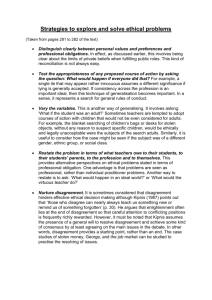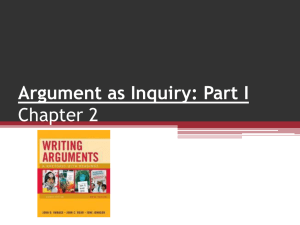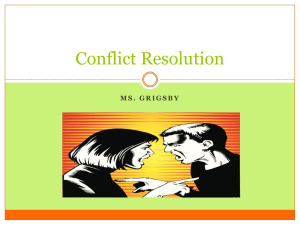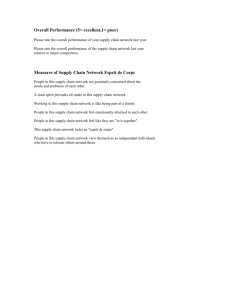pptx - SAPICS Conference
advertisement
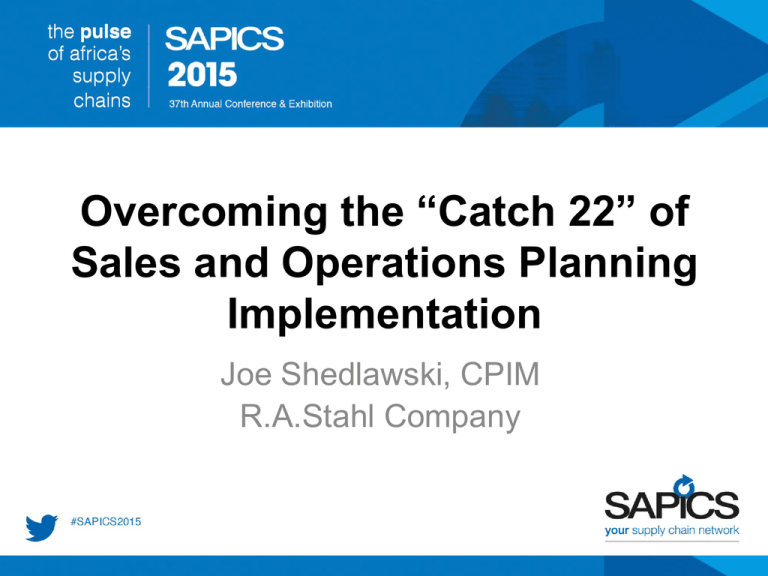
Overcoming the “Catch 22” of Sales and Operations Planning Implementation Joe Shedlawski, CPIM R.A.Stahl Company Agenda • Introduction • Why Engage Top Management • The Elements of Successful S&OP • What's the Challenge (Catch '22’) • How to Engage Top Management • Discussion Introduction What is a Catch 22? A catch-22 is a paradoxical situation from which an individual cannot escape because of contradictory rules Why Engage Top Management? Top Management’s Role: “Keep the Herd Moving, Roughly West” Energy Alignment Accomplishment Accomplishment Sales/Marketing (Units or $ by Family) Finance (Gross Revenue) Executive S&OP A process to raise and reconcile disagreement/conflict, agree upon, & communicate THE company game plan Operations (Units/hours/ Material) Product Development (New Product Issues) Implementation Alternatives Hard Benefits • Customer service • Inventory • Obsolescence • Freight cost • Order lead times • Supplier lead times • Time to launch new products • Plant productivity UP DOWN DOWN DOWN DOWN DOWN DOWN UP Soft Benefits • • • • • • • • Enhanced teamwork Improved communications – institutionalized Better decisions with less effort and time Better $$$ plans with less effort and time Greater accountability and control Enhanced execution of strategic plans Window into the future Energy alignment: Keep the herd moving roughly west The Elements of Successful Executive S&OP Top Management’s Place ProActive Volume Behavior Supply Demand ReActive Behavior •How Much? •Rates •Market Facing Families •The Big Picture •Strategy/Policy/Risk •Monthly / 18 - 36 Mos •Executive Responsibility Mix •Which Ones? •Timing/Sequence •The Details •Products/SKU’s/Orders •Tactics/Execution •Weekly/Daily 1-3 Months •Middle Mgt. Responsibility What’s the Challenge? Keeping that herd moving roughly west is more of a cultural challenge than a technical one! Culture • Interpersonal relationships reflect the culture of an organisation • The sum of those relationships defines the organisation’s culture • These relationships reflect a web of implicit and explicit agreements throughout the organisation Research (AMR study, 2010) Success with Executive S&OP consists of: • 10% technology • 30% process definition and discipline • 60% culture change Cultural Changes: • Post-S&OP Pre-S&OP • Lack of involvement by Top Management • Acceptance of poor data • Silo mentalities that inhibit interdepartmental collaboration • Reactive decision making • Inter-functional collaboration, with open trust between departments • Data-driven decisions • High level of crossfunctional discipline Proactive approaches to demand and supply plans * How S&OP Changes Corporate Culture: Results from Interviews with Seven Companies Stahl/Mello; Foresight Journal: Winter 2010 Top Management’s Role In Executive S&OP, it’s necessary to voice disagreements! Management must: • Create a culture that allows the Ugly Moose to be put on the table -- so that they can completely and effectively resolve disagreements and conflict, setting proper: – – – – Policy Strategy Risk assessment Performance measurements Before it’s in the MIX Space! Conflict Resolution * • Disagreement has two parts: – Substantive issue – Emotion behind that issue • Disagreement becomes conflict when the emotion is not completely addressed • Lasting conflict resolution must deal with both elements of disagreement • Doing that effectively can be learned: – With a motive to do so and – A framework on which to work * “Getting to Resolution” Stewart Levine Top Management’s Catch 22 • If Top Management does get involved from the very beginning: – There is risk of personal or organisational discomfort that comes from changing the culture – BUT that is necessary to bring about lasting results • If Top Management does not get so involved and committed: – There is less personal risk of disruption – BUT there will likely not be any substantial business improvement * Overcoming the "Catch 22" of Implementation by Robert A. Stahl and Joseph F. Shedlawski Foresight Journal Spring 2012 How to Engage Top Management “The Big Lie of Strategic Planning” Harvard Business Review – Jan/Feb 2014 by Roger Martin “A detailed plan may be comforting, but it’s not a strategy.” The Problem: Executives know that strategy is important. But almost all find it scary, because it forces them to confront a future they can only guess at. Strategy making is uncomfortable. The Solution: Reconcile yourself to feeling uncomfortable, and follow three rules: 1. Keep it simple 2. Don’t look for perfection 3. Make the logic explicit Engage Top Management • Identify and enlist an Executive Champion; someone with executive influence, willing to “put skin in the game” • Connect the hard benefits of executive S&OP to successful implementation • Follow a path of low risk/low cost • Obtain quick results to build confidence • Provide feedback on progress/success • Generate local ownership and enthusiasm Business Improvement Low Risk Implementation Path Executive Briefing Go/No-Go #1 Live Pilot Demonstration Go/No-Go #2 Kickoff Session Phase II Expansion Low Cost Low Risk High Impact Quick Results Phase I Pilot Demo 1 2 3 4 Months Phase III Financial Integration 5 6 7 8 9 Leadership’s Role During Change: Immerse in the Detail • • • • • • • Lead educational process Manage cultural changes Assure proper resources Approve procedures Insist on clear targets (goals) Participate Measure progress Leadership’s Role (Continued) Ongoing: Remove from Detail • • • • • Insist on meaningful participation Insist proper homework be done Raise and resolve disagreement and conflict Make clear decisions Hold people accountable to process and to results • Encourage and expect realistic improvement • Lead management development • Measure performance Corporate Role* • Mandate the fundamental concepts and principles of executive S&OP • Demonstrate a willingness to air disagreement • Assure resources to develop necessary and appropriate tools • Track progress – process discipline, cultural, key performance measures • Reward success * S&OP Principles: The Foundation for Success Robert A. Stahl and Thomas F. Wallace Foresight Journal Fall 2012 Discussion Thanks for Listening! joeshedlawski@gmail.com
